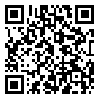BibTeX | RIS | EndNote | Medlars | ProCite | Reference Manager | RefWorks
Send citation to:
URL: http://pejouhesh.sbmu.ac.ir/article-1-1512-en.html

 , Mahmood Jamshidian
, Mahmood Jamshidian 
 , Taghii Zahraei Saleh
, Taghii Zahraei Saleh 
 , Gholam Reza Nikbakht Boroujeni
, Gholam Reza Nikbakht Boroujeni 
 , Kumarss Amini
, Kumarss Amini 

Background: Salmonellosis is a zoonotic disease of human and animals. One of the most mportant serovars in human, livestock and poultry is Salmonella enteritidis which is a worldwide common foodborne pathogen. The aim of this study was differentiation and to determine the relationship among different isolates of Salmonella enteritidis by molecular fingerprinting method based on repeated sequences (rep-PCR).
Materials and Methods: In a cross-sectional study, 64 isolates of Salmonella Enteritidis from various sources (beef, poultry and humans) were studied by rep-PCR method. The molecular patterns were determined on the basis of the existence or absence and the size of bands. By using a computer program NTSYS, dendrogram were drawn.
Results: The number of 5-14 bands with the approximate size of 100 to 3,000 base pairs with a common bond (bp 400) were observed. The number of molecular profiles obtained by REP1R and REP2I primers for 64 isolates of Salmonella Enteritidis were 38 profiles.
Conclusion: The results showed that most strains of Salmonella Enteritidis isolates from human were classified separately from non-human (poultry and beef) isolates and the high genetic heterogeneity was observed.
Received: 2015/11/20 | Accepted: 2016/07/2 | Published: 2016/10/11
| Rights and permissions | |
 |
This work is licensed under a Creative Commons Attribution-NonCommercial 4.0 International License. |




